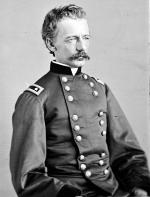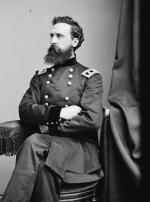![header=[Marker Text] body=[The Union Army 12th Corps arrived here on the afternoon of July 1, 1863; and later moved into battle line on Culp's Hill. On July 2, the 6th Corps arrived by this same road, and the 5th Corps by the Hanover Road] sign](http://explorepahistory.com/kora/files/1/10/1-A-1FE-139-ExplorePAHistory-a0h2r1-a_450.jpg)
Mouse over for marker text
Name:
Gettysburg Campaign [Twelfth Corps]
Region:
Hershey/Gettysburg/Dutch Country Region
County:
Adams
Marker Location:
Baltimore Pike (State Route 2035) 2 miles southeast of Gettysburg near junction of US 15 and PA Route 97.
Dedication Date:
December 12, 1947
Behind the Marker
Without a doubt, the actions of the Twelfth Corps on July 1 remain one of the great mysteries of the battle of Gettysburg. On the night of June 30, the Twelfth Corps was in camp a mile from Littlestown. Acting under orders, on July 1 its two divisions moved seven miles to a little hamlet called Two Taverns, down the Baltimore Pike less than five miles from Gettysburg.
Major General Henry W. Slocum was commander of the corps. An 1852 West Point graduate who had gone into law prior to the war, Slocum in 1861 became colonel of a New York regiment, then worked his way up through successive appointments to command of the corps in October 1862. At Gettysburg, his corps included five brigades of perhaps 8,000 soldiers, who were led by Division Commanders Alpheus S. Williams and John W. Geary.
John W. Geary.
For the men in the corps, the order to go into bivouac at Two Taverns was certainly mysterious. Many later claimed they could hear the faint sounds of the battle raging to the northwest. Slocum thought it was merely the noise of a cavalry skirmish. One apologist later claimed that an adverse wind prevented the general from hearing the battle. General George G. Meade's morning circular had advised Slocum to be cautious in case the Rebels attacked. At the time he wrote this circular, Meade was still thinking of fighting a defensive battle behind Pipe Creek, Maryland.
General George G. Meade's morning circular had advised Slocum to be cautious in case the Rebels attacked. At the time he wrote this circular, Meade was still thinking of fighting a defensive battle behind Pipe Creek, Maryland.
Meade's order also stipulated that Slocum would receive further information from General John F. Reynolds at Gettysburg about the location of the enemy. So Slocum waited. And waited. Reynolds was killed that morning.
General John F. Reynolds at Gettysburg about the location of the enemy. So Slocum waited. And waited. Reynolds was killed that morning.
His successor, General Oliver O. Howard, did not send a message to Slocum until that afternoon. But Howard was not a good writer. His message to Slocum, which failed to mention that Reynolds had been slain, merely stated that the troops at Gettysburg were engaged with the enemy.
A later message from Howard was no clearer, but an aggressive general, by then, would have realized that his men might be needed on the battlefield. Unfortunately, Slocum, sometimes nicknamed "Slow-Come," failed to interrogate the messengers, or march to the sound of the guns.
Once he learned the situation at Gettysburg, Meade sent an aide to Slocum with orders to move. And so, sometime after three o'clock, the Twelfth Corps finally marched toward Gettysburg, arriving only after the fighting was over. Slocum, as senior general, then assumed command when General Winfield S. Hancock left to report to Meade.
General Winfield S. Hancock left to report to Meade.
Behind the Twelfth Corps came the Fifth Corps, Meade's old command. That evening, Major General George Sykes, the new corps commander, halted his corps just west of Hanover. But a message from Meade warning Sykes of the fighting at Gettysburg and the need for haste ended the soldiers' short rest.
Marching via today's Pennsylvania Route 116, the soldiers trudged through the night, passing through McSherrystown and Bonneautown (modern Bonneauville) before halting. At daybreak on July 2, Sykes again had his men on the move. Turning south onto a dirt road on Brinkerhoff Ridge about two miles from Gettysburg, the column moved into position on the army's right flank.
On July 1 the Army of the Potomac's largest corps, the Sixth, was still camped at Manchester in Maryland. When word of the fighting at Gettysburg reached corps headquarters, Major General John Sedgwick also received orders to march his 15,000 men to the battlefield via Taneytown.
Once the corps had already started, however, fresh orders from Meade specified that Sedgwick was to take the shortest route to Gettysburg. So the corps had to march back several miles to reach the Baltimore Pike (Route 97). From this junction it was thirty-seven miles to Gettysburg.
When the Union army was on the move, soldiers usually marched for fifty minutes every hour, then stopped for a ten-minute breather before continuing. Veteran troops usually could cover two to three miles every hour. At that pace the Sixth Corps would have reached the battle in a minimum of thirteen hours.
The march of the Sixth Corps to Gettysburg, however, was to become one of the epic treks in American military history. Years after the war, participants recalled with pride how "Uncle John" Sedgwick and his men reached the battlefield late in the afternoon of July 2, just in time to reinforce the Union line on Cemetery Ridge.
It is unlikely, however, that the men of the Sixth Corps beamed with pride as they trudged through the night along the Baltimore Pike. Many soldiers sleepwalked, kept in column by their comrades. After a brief halt at dawn, the column was on the road again before the men could prepare a proper breakfast over campfires.
That morning, the heat and humidity of a summer day soon prevailed. Dust nearly suffocated the marching, weary soldiers, but they continued on, knowing that a battle was in progress on their own soil. Civilians along the route gave food and water to the passing blue column. Men fell behind from blistered feet and fatigue, to be picked up by ambulances or prodded along by the rearguard.
Finally, five or so miles from Gettysburg, Sedgwick halted the corps for an hour's rest while he went on to report to Meade. The general had kept his word, for at four o'clock the vanguard of the corps approached the field. The Army of the Potomac was finally united at Gettysburg. The tired soldiers wearing the Greek Cross marched onto the battlefield just in time to reinforce the main Union line along Cemetery Ridge and discourage any further Confederate attacks.
Major General Henry W. Slocum was commander of the corps. An 1852 West Point graduate who had gone into law prior to the war, Slocum in 1861 became colonel of a New York regiment, then worked his way up through successive appointments to command of the corps in October 1862. At Gettysburg, his corps included five brigades of perhaps 8,000 soldiers, who were led by Division Commanders Alpheus S. Williams and
For the men in the corps, the order to go into bivouac at Two Taverns was certainly mysterious. Many later claimed they could hear the faint sounds of the battle raging to the northwest. Slocum thought it was merely the noise of a cavalry skirmish. One apologist later claimed that an adverse wind prevented the general from hearing the battle.
Meade's order also stipulated that Slocum would receive further information from
His successor, General Oliver O. Howard, did not send a message to Slocum until that afternoon. But Howard was not a good writer. His message to Slocum, which failed to mention that Reynolds had been slain, merely stated that the troops at Gettysburg were engaged with the enemy.
A later message from Howard was no clearer, but an aggressive general, by then, would have realized that his men might be needed on the battlefield. Unfortunately, Slocum, sometimes nicknamed "Slow-Come," failed to interrogate the messengers, or march to the sound of the guns.
Once he learned the situation at Gettysburg, Meade sent an aide to Slocum with orders to move. And so, sometime after three o'clock, the Twelfth Corps finally marched toward Gettysburg, arriving only after the fighting was over. Slocum, as senior general, then assumed command when
Behind the Twelfth Corps came the Fifth Corps, Meade's old command. That evening, Major General George Sykes, the new corps commander, halted his corps just west of Hanover. But a message from Meade warning Sykes of the fighting at Gettysburg and the need for haste ended the soldiers' short rest.
Marching via today's Pennsylvania Route 116, the soldiers trudged through the night, passing through McSherrystown and Bonneautown (modern Bonneauville) before halting. At daybreak on July 2, Sykes again had his men on the move. Turning south onto a dirt road on Brinkerhoff Ridge about two miles from Gettysburg, the column moved into position on the army's right flank.
On July 1 the Army of the Potomac's largest corps, the Sixth, was still camped at Manchester in Maryland. When word of the fighting at Gettysburg reached corps headquarters, Major General John Sedgwick also received orders to march his 15,000 men to the battlefield via Taneytown.
Once the corps had already started, however, fresh orders from Meade specified that Sedgwick was to take the shortest route to Gettysburg. So the corps had to march back several miles to reach the Baltimore Pike (Route 97). From this junction it was thirty-seven miles to Gettysburg.
When the Union army was on the move, soldiers usually marched for fifty minutes every hour, then stopped for a ten-minute breather before continuing. Veteran troops usually could cover two to three miles every hour. At that pace the Sixth Corps would have reached the battle in a minimum of thirteen hours.
The march of the Sixth Corps to Gettysburg, however, was to become one of the epic treks in American military history. Years after the war, participants recalled with pride how "Uncle John" Sedgwick and his men reached the battlefield late in the afternoon of July 2, just in time to reinforce the Union line on Cemetery Ridge.
It is unlikely, however, that the men of the Sixth Corps beamed with pride as they trudged through the night along the Baltimore Pike. Many soldiers sleepwalked, kept in column by their comrades. After a brief halt at dawn, the column was on the road again before the men could prepare a proper breakfast over campfires.
That morning, the heat and humidity of a summer day soon prevailed. Dust nearly suffocated the marching, weary soldiers, but they continued on, knowing that a battle was in progress on their own soil. Civilians along the route gave food and water to the passing blue column. Men fell behind from blistered feet and fatigue, to be picked up by ambulances or prodded along by the rearguard.
Finally, five or so miles from Gettysburg, Sedgwick halted the corps for an hour's rest while he went on to report to Meade. The general had kept his word, for at four o'clock the vanguard of the corps approached the field. The Army of the Potomac was finally united at Gettysburg. The tired soldiers wearing the Greek Cross marched onto the battlefield just in time to reinforce the main Union line along Cemetery Ridge and discourage any further Confederate attacks.







